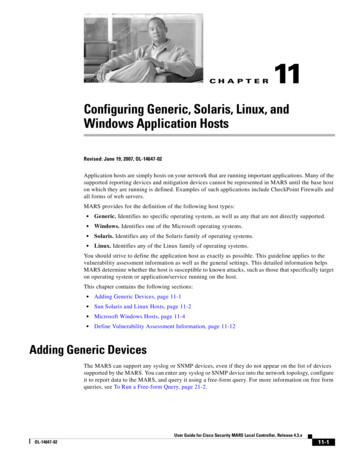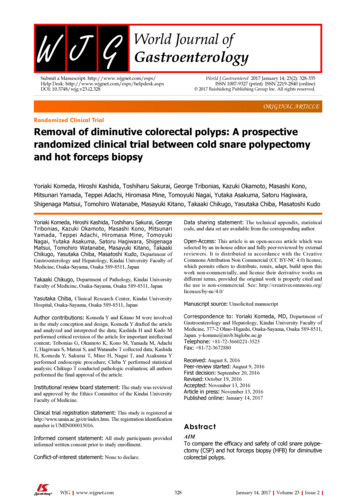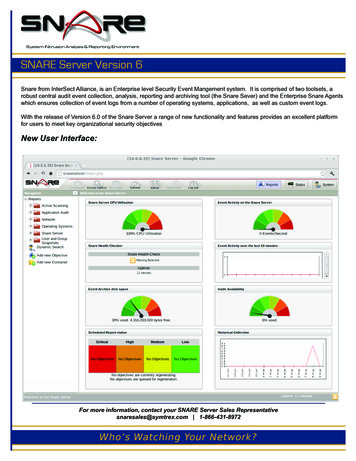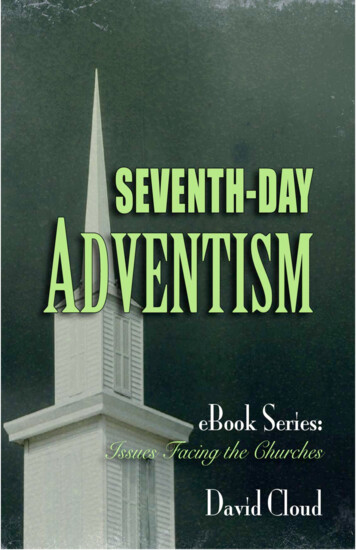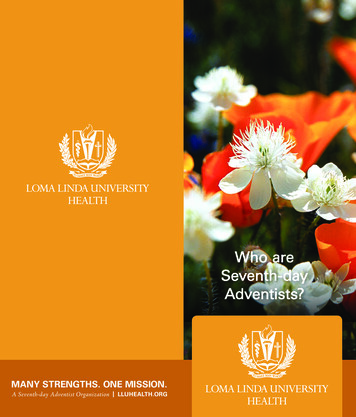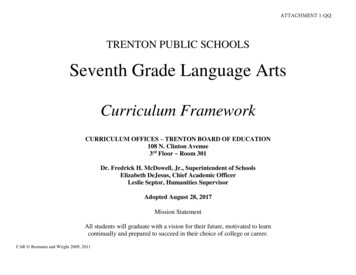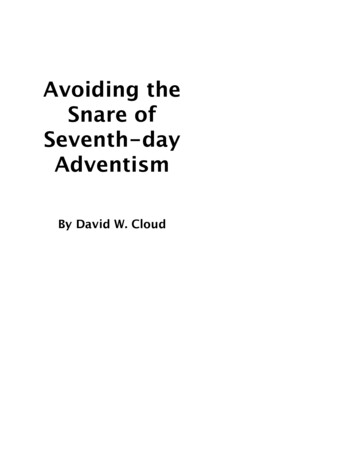
Transcription
Avoiding theSnare ofSeventh-dayAdventismBy David W. Cloud
Avoiding the Snare of Seventh-day AdventismCopyright 1984, 1999, 2008 by David W. CloudSecond edition enlarged 1999Third edition updated, edited, enlarged September 2008ISBN 1-58318-036-2Published byWay of Life LiteratureP.O. Box 610368, Port Huron, MI 48061-0368866-295-4143 (toll free) fbns@wayoflife.org (e-mail)http://www.wayoflife.org (web site)2
Canada:Bethel Baptist Church, 4212 Campbell St. N., London, Ont. N6P 1A6519-652-2619 (voice) 519-652-0056 (fax)3
ContentsIntroduction: Adventists Wanted Me to Revise This Book4Adventist History Proves It Is Heretical8Adventist Doctrine Proves It Is Heretical18Heresy #1: Grace Includes the Works of the Law18Heresy #2: Sabbath-KeepingHeresy #3: Soul SleepHeresy #4: Annihilation of the WickedHeresy #5: Ellen White a ProphetessHeresy #6: Investigative JudgmentHeresy #7: Misuse of the Mosaic LawHeresy #8: Vegetarianism30445763849097Walter Martin and Seventh-day Adventism103Seventh-day Adventism, Ecumenism, and Hell121Who Was D.M. Canright?128My Experience of Twenty-Eight Years in Adventism130Origin, History, and Failures of Adventism151Mrs. White and Her Revelations166Bibliography2044
established in the mid-nineteen century. “Seventh-day”refers to sabbath worship. “Adventist” refers to theirbelief that God raised them up to announce the comingof the Lord. They have 15 million members worldwidein 61,000 churches. They are working in 203 countriesand 885 languages and dialects. They operate 63publishing houses, 748 hospitals, clinics, and nursinghomes, and 7,200 schools.Adventists Wanted Me to Revise This BookThe following study is based directly upon Seventh-dayAdventist publications. In researching this report, theauthor visited Adventist bookstores, colleges, andchurches. I also took some of their correspondencecourses. Though some of the books used for ourdocumentation of Adventist belief were written in the1800s and early 1900s, they are still being producedby Adventist publishing houses and distributed to thepublic throughout the world.In 1990 I received a letter from the editor of theAdventist periodical Ministry, challenging me to basemy investigation of their beliefs solely upon onerecently published volume entitled Seventh-dayAdventists Believe. In a review of Avoiding the Snare ofSeventh-day Adventism, they claimed that by usingolder sources I was misrepresenting their doctrine.That idea is a clever deception for the followingreasons:5
First, Seventh-day Adventists Believe, the book theysent to define official Adventism, promotes thesame heresies that I expose in Avoiding the Snare ofSeventh-day Adventism. The issue is a smokescreen.Second, Seventh-day Adventists Believe containshundreds of citations of exactly the same works andauthors I cite in my book. In fact, the vast majority ofthe footnotes in Seventh-day Adventists Believe citeSDA publications before 1970, which is exactly theissue they criticize me about. If they can quote theseolder works as authoritative, so can I!Third, many of the quotations in Avoiding the Snareof Seventh-day Adventism are taken directly fromEllen White’s writings. The SDA claim that White wasan inspired prophetess. If they reject her writings asundependable, they pull the rug out from underthemselves.Fourth, in their own writings they admit that theirdoctrinal landmarks were settled before 1850.“By the year 1850 the lines of fundamental truth were quite wellunderstood and clearly defined. Looking back in 1905, [EllenWhite] wrote, ‘The truth for this time God has given us as afoundation for our faith. He Himself has taught us what is truth. .We are not to receive the words of those who come with amessage that contradicts the special points of our faith’” (TheSpirit of Prophecy Treasure Chest, p. 122; this book wasdistributed with an advanced SDA correspondence course that Itook).This same Adventist publication lists five “pillars oftheir faith”: the Second advent, sabbath worship, thethird angel’s message, investigative judgment, and thenon-immortality of the soul (soul sleep and theannihilation of the unsaved). It is ridiculous for theAdventists to criticize me for using older documentswhen they themselves state in formal publications thattheir doctrinal platform was fully laid by the middle ofthe 19th century.6
Finally, the publications I quote in this study arestill in print and are distributed by the Seventh-dayAdventists themselves. They do not contain any typeof disclaimer to warn readers that the contents mightnot reflect official Adventist belief. If the Adventists donot want people to judge them by these older books,they should stop printing them and publish a statementdisassociating themselves from these books. In myreply to the SDA publication Ministry on February 9,1990, I said:I have considered the review you sent by William Shea and thestatements made in your own letter and must stand behind thecontents of my book. I offer the following reasons for this:1. Shea’s review is superficial, insidious, and does not deal withthe weighty and thorough arguments I have given for mypositions.2. The sources for my conclusions about SDA doctrine are basedsolidly upon the writings of prophetess Ellen G. White and uponlegitimate materials published by official Seventh-day Adventistpresses. Most of these writings were purchased from thebookstore at your school in Collegedale, Tennessee. Others wereobtained from correspondence courses offered by the Seventhday Adventist Church.These materials, at least the vast majority of them, are still in printand are still promulgated. If the materials I purchased from youand which I quoted in my book are not to be considered reliablestatements of Adventist belief, why do you crusade them beforethe public? Why are there no disclaimers on these writings,warning people that the statements contained therein are notdependable and not to be trusted in forming opinions aboutAdventism?3. I would come to the same conclusions about Adventist beliefand write virtually the same book by using only prophetess EllenWhite’s published writings. Are her writings—the ones theAdventist church publishes—not reliable?4. I would come to the same conclusions about Adventist beliefand write virtually the same book by using only the so-called“official Seventh-day Adventist doctrinal book,” Seventh-dayAdventists Believe. The statements of Adventist doctrine made inSeventh-day Adventists Believe are more cleverly presented than7
in some of the other publications, but the same sad old heresiesare there.For these reasons I see no need to revise my book Avoiding theSnares of Seventh-day Adventism. If the time comes wherein youreject the writings of Ellen G. White and her position as aprophetess, and you reject the heretical “pillars” of the Seventhday Adventist church which were developed and promoted byWhite and other early Adventist leaders, I will then be glad toreevaluate your beliefs.I repeat, the entire matter is a smokescreen. TheAdventists are trying to veil some aspects of theirdoctrine and history in order to gain a wider hearingand to obtain proselytes, while holding to the verythings they are trying to veil. Seventh-day Adventismhas not changed at heart, but it is trying to put on anew face.8
Adventist History Proves It sappointed Second Coming movement of the 1800’s.William Miller, a Baptist layman, concluded in 1818 thatChrist would return to earth in 1843. When that wasproven wrong, he changed the date to October 22,1844. This belief was based largely on an interpretationof Daniel chapters nine and twelve using the erroneousday/year equation (one prophetic day equals onehistorical year). Tens of thousands followed Miller’sconclusions, and many diverse, unscriptural adventist(advent refers to Christ’s coming) groups sprang upwithin this excited religious atmosphere.Until the end of 1844, Miller held resolutely to hisconviction that Christ would return to “cleanse thesanctuary,” which he interpreted to mean the earth.After the set dates passed, Miller wisely left off withdate setting, admitted his mistake, and no longerparticipated in the adventist movement. He did notbecome a Seventh-day Adventist.From the shambles of the confused and unscripturaldate-setting movement, there emerged various groupswith various doctrinal peculiarities. Some of thesegroups were gradually formed into Seventh-dayAdventism. The following history from Seventh-dayAdventist publications contains the major points in thisformation.1. A group of Advent followers in New Hampshireadopted sabbath-keeping in 1844 and began to9
publish their views through pamphlets. Among thesewere Joseph Bates and James White.2. Some of these sabbath-keepers accepted the visionsof Hazen Foss and Ellen Harmon in relation to the“Investigative Judgment” doctrine and the “ThirdAngel’s Message” of Revelation 14:9-12. The doctrineof investigative judgment, as taught by the SDAChurch, claims that in 1844 Christ entered into theheavenly holy of holies to begin investigating therecords of human works. It is supposed that thisinvestigation will decide the eternal destinies of allmen. The “Third Angel’s Message,” which is a warningagainst taking the mark of the beast and speaks of“they that keep the commandments of God, and thefaith of Jesus” (Rev. 14:9, 12), was erroneously taken bythe Adventists to refer to themselves, since they upholdthe sabbath. An SDA publication relates these events asfollows:Near the time of the expected advent in the fall of 1844, there wasalso given to Hazen Foss, a young Adventist of talent, arevelation of the experience of the advent people. Shortly afterthe passing of the time, he was bidden to relate the vision toothers, but this be disinclined to do. He was warned of God as tothe consequences of failing to relate to others what had beenrevealed to him, and was told that if he refused, the light would begiven to someone else. But he felt keenly the disappointment of1844, and ‘said that he had been deceived.’ After a severe mentalconflict, he ‘decided he would not relate the visions.’ Then, ‘verystrange feelings came to him, and a voice said, ‘You have grievedaway the Spirit of the Lord’ (E.G. White Letter No. 37, 1890).‘Horrified at his stubbornness and rebellion,’ he ‘told the Lord thathe would relate the vision,’ but when he attempted to do so beforea company of believers, he could not call it to mind. In vain werehis attempts to call up the scenes as they had been shown to him;and then in deep despair he exclaimed, ‘It is gone from me; I cansay nothing, and the Spirit of the Lord has left me.’ Eyewitnessesdescribed it as ‘the most terrible meeting they were ever in.’Early in 1845, Foss overheard Ellen Harmon relate her first visionto the company of believers at Portland, Maine. He recognizedher account as a description of what was shown him. Uponmeeting her the next morning, he recounted his experience, ofwhich she had not before known, and encouraged her to faithfully10
perform her work, stating: ‘I believe the visions are taken from meand given to you. Do not refuse to obey God, for it will be at theperil of your soul. I am a lost man. You are chosen of God; befaithful in doing your work, and the crown I might have had, youwill receive.’ On comparing dates, they discovered that it was notuntil after he had been told that the visions were taken from him,that Ellen Harmon was given her first revelation. Although HazenFoss lived till 1893, he never again manifested interest in mattersreligious (Arthur L. White, Ellen G. White—Messenger to theRemnant, revised to 1969, p. 30).The agent of this gift [Ellen Harmon] was called to service in1844. Later those associated with this gift came in contact withthe Bible teaching already referred to—the truths of the Sabbathand of the heavenly sanctuary and the judgment hour. Thus wasformed the nucleus of the definite Advent Movement of theprophecy. We see the various special factors all having their rootsin 1844. And from that day to this, the people of the prophecyhave been hastening on toward all nations with the gospelmessage of preparation to meet the Lord” (William Spicer, Gift ofProphecy In the Seventh-day Adventist Church, p. 13).Early Adventists Denied the TrinityEarly pioneers of Seventh-day Adventism also deniedthe doctrine of the Trinity. These included James White(husband of “prophetess” Ellen White), William White(the son of James and Ellen), James Edson, Uriah Smith,Joseph Bates, J.H. Waggoner, J.B. Frisbie, G.I. Butler, J.N.Andrews, D.W. Hull, E.J. Waggoner, R.F. Cottrell, A.J.Dennis, J.N. Loughborough, A.T. Jones, D.M. Canright,and W.W. Prescott.All of these taught that God the Father alone is the Onesupreme, eternal, self-existent, immortal God, that theHoly Spirit is the representative of God who comesforth from the Father but is not a Person in his ownright, and that Jesus Christ derived his divine attributesby virtue of inheritance and that he preceded from theFather.Consider the following quotes:“To assert that the sayings of the Son and his apostles are thecommandments of the Father, is as wide from the truth as the old11
Trinitarian absurdity that Jesus Christ is the very and eternalGod” (James White, Review and Herald, Aug. 5, 1852, p. 52).“We should rather mistrust that the Sunday God [the Trinity] camefrom the same [pagan] source that Sunday-keeping did” (J.B.Friesbie, “The Sunday God,” Review and Herald, Feb. 28, 1854).“There are many objections which we might urge [against theTrinity], but on account of our limited space we shall reduce themto the three following: 1. It is contrary to common sense. 2. It iscontrary to scripture. 3. Its origin is pagan and fabulous ” (J.N.Loughborough, Review and Herald, Nov. 5, 1861).“ the Trinity, or the triune God, is unknown to the Bible” (R.F.Cottrell, Review and Herald, June 1, 1869).“The Scriptures abundantly teach the pre-existence of Christ andhis divinity; but they are entirely silent in regard to a Trinity” (J.H.Waggoner, The Atonement, chapter four, “The Doctrine of aTrinity Subversive of the Atonement,” 1872, p. 165).“The Scriptures nowhere speak of Christ as a created being, buton the contrary plainly state that he was begotten of the Father. These testimonies show that Christ is now an object of worshipequally with the Father; but they do not prove that with him heholds an eternity of past existence” (Uriah Smith, Thoughts onDaniel and Revelation). [This book originally contained many nonTrinitarian statements until they were removed in 1944.]“ the Bible never uses the phrases, ‘Trinity,’ ‘triune God,’ ‘threein one,’ ‘the holy three,’ ‘God the Holy Ghost,’ etc. but it doesemphatically say there is only one God, the Father. And everyargument to prove three Gods in one person, God the Father,God the Son, and God the Holy Ghost, all of them of onesubstance, and every way equal to each other, and all threeforming but one, contradicts itself, contradicts reason, andcontradicts the Bible ” (D.M. Canright, Review and Herald, Aug.29, 1878).Early Adventist statements of faithTrinitarian. The 1872 statement said:werenon-“That there is one God, a personal, spiritual Being, the Creator ofall things, omnipotent, omniscient, and eternal, infinite in wisdom,holiness, justice, goodness, truth, and mercy; unchangeable, andeverywhere present by His representative, the Holy Spirit. Thatthere is one Lord Jesus Christ, and Son of the Eternal Father, theOne by whom God created all things ”12
Throughout the first part of the twentieth century therewere hot debates within Adventism on the subject ofthe Trinity, the eternality of Christ, the personality ofthe Holy Spirit, and related doctrines. When J.H. Kelloggtaught Trinitarian doctrine in his book Living Temple in1903, he was resisted by G.I. Butler and other Adventistleaders. The 1919 Adventist Bible Conferencewitnessed similar battles. Obviously there were stillmany leaders within Adventism in the early part of thecentury that rejected the Trinity.It was under the direction of Leroy Froom that Seventhday Adventism gradually rejected the non-Trinitarianposition. His 1928 book, The Coming of the Comforter,taught Trinitarian doctrine. A Trinitarian statementappeared in print as an official Adventist position forthe first time in 1931. There were still many Adventiststhat did not believe in the Trinity, but this wasbecoming the minority view.In 1941, a uniform baptismal covenant was publishedthat included Trinitarian language. Froom was amember of the committee that drew up the covenant.In 1942, a committee was appointed to delete nonTrinitarian statements from Uriah Smith’s book onDaniel and Revelation, and the 1944 revision containedthese changes.At that time, Adventist leaders sought to revise theirown history by claiming that Ellen White was aTrinitarian and that she did not support the nonTrinitarian position of other Adventist pioneers. Thatthis was an error is evident by the fact that herhusband, James White, remained an avowed antiTrinitarian to his death and Ellen never sought tocorrect him or other anti-Trinitarian leaders. Her sonsWilliam and James were both anti-Trinitarians.Furthermore, Ellen White publicly supported UriahSmith’s book until her death in 1915. The fact is thatEllen White’s own statements touching the doctrine of13
the Trinity were somewhat nebulous, as her own sonWilliam admitted, and could be used both byTrinitarians and non-Trinitarians.What Do These Strange Roots Tell Us?The advent movement was unbiblical from itsinception. The Lord Jesus plainly warned against settingdates for His return:“But of that day and hour knoweth no man, no, not the angels ofheaven, but my Father only” (Mt. 24:36).“Watch therefore; for ye know not what hour your Lord dothcome” (Mt. 24:42).“Therefore be ye also ready: for in such an hour as ye think notthe Son of man cometh” (Mt. 24:44).“Watch therefore, for ye know neither the day nor the hourwherein the Son of man cometh” (Mt. 25:13).“But of that day and that hour knoweth no man, no, not the angelswhich are in heaven, neither the Son, but the Father. Take yeheed, watch and pray: for ye know not when the time is” (Mk.13:32-33).“It is not for you to know the time or the seasons, which theFather hath put in his own power” (Acts 1:7).Every religious movement, no matter how sincere andfervent, that has set dates for the second coming ofChrist has done so in direct opposition to Jesus’warnings. William Miller was probably sincere in hiszeal to proclaim Jesus’ soon return, but he wassincerely wrong. He was deluded, together with thosewho followed him, including those who later becamemembers of Seventh-day AdventismFurther, the doctrine of sabbath worship for NewTestament believers is a heresy in direct contradictionto Bible teaching. “Let no man therefore judge you inmeat, or in drink, or in respect of an holyday or of thenew moon, or of the sabbath days” (Col. 2:16). Those14
within the advent movement who accepted thesabbath-keeping doctrine were being led farther andfarther from the truth.First there was the date-setting error, then the sabbatherror, then the Investigative Judgment error, and thenthe error of rejecting the Trinity.Hazen Foss was not dealing with the God of the Bible.The gifts and calling of the true God do not change(Rom. 11:29). Stubborn prophets and ministers aredealt with as rebellious children until brought torepentance, as Jonah was, but their gift and callingremains. Even though poor Foss repented and earnestlyagreed to obey the visions, he was rejected by theangel and told that he had “grieved away the HolySpirit.”The Bible says the New Testament believer is sealed bythe Holy Spirit “unto the day of redemption” (2 Cor.1:22; Eph. 1:12-14; 4:30). Praise the Lord, He cannotbe grieved away! The angel that dealt with Hazen Fosswas a liar! He was a deceiving spirit, a fallen angelunder the command of the father of lies—the devil. Thereligious movement that has arisen upon the visions ofthis angel is as deceitful and false as he is.There is an urgent need to learn from the Adventists’mistakes. To disobey Romans 16:17 is a serious errorand often leads to spiritual shipwreck. The Adventistsignored clear biblical teaching on the second comingand followed a movement based upon doctrinescontrary to the Bible’s teaching. Many were then led toother, more serious errors, culminating in theformation of the Seventh-day Adventist cult.When we find that a church is teaching doctrine that iscontrary to the Bible, we must avoid it in obedience toRomans 16:17. No matter how much supposed good is15
in the movement, it must be avoided if it promotesteachings contrary to Scripture.A Closer Look at the Roll of Ellen G. White’s Visionsin the Formation of the SDAEllen White’s father, Robert Harmon, was a follower ofWilliam Miller. As a result of their acceptance ofadventist theories, the Harmons, Ellen included, weredropped from the membership of the Methodist churchin Portland, Maine, in 1843 (D.A. Delafield, Ellen G.White and the S.D.A., p. 87). Ellen had made a personalcommitment to adventism during a sermon by Miller,and at age 17 she allegedly began receiving visionsconcerning this movement. This began soon afterOctober 1844, the last date that had been set by Miller,and in these visions many adventists saw the leadinghand of God in answer to their bewilderment anddesperation.Theteenagegirlwasallegedlycommanded by the revealing “angel” to proclaim thevisions to others, and as she did so a following ofadventists rallied around her as a prophetess of God.“Back in December 1844, in her first prophetic vision, she wasshown the advent people traveling on an elevated road toheaven, with a brilliant light illuminating their pathway. At the endof this path was the golden City of God, the New Jerusalem,described by John in the last chapters of the Revelation. The lightshining from the commencement of the trail was symbolic of theLord’s presence with the movement from its beginning until thesecond coming of the Lord . ‘In my second vision . about aweek after the first, the Lord gave me a view of the trials throughwhich I must pass, and told me that I must go and relate to otherswhat He had revealed to me . Said the angel . Deliver themessage faithfully; endure unto the end, and you shall eat thefruit of the tree of life and drink of the water of life’” (Ellen G.White and the Seventh-day Adventist Church, pp. 12- 13).Seventh-day Adventism was guided both in its doctrineand practice by this female voice, believed to possessthe gift of prophecy and to be an inspired commentatorof Scripture. Note the following quotation from an SDApublication:16
Mrs. White’s preeminent mission was to help build the dynamicsof a Biblical faith into a Christian movement. The Seventh-dayAdventist Church is indebted to her as a spiritual leader and apioneer builder and guide. In most of the soulwinning activities ofthe church, from its very beginnings, the leaders receivedguidance from what they believed were the propheticinsights of this servant of God (Ellen G. White and the SDAChurch, pp. 10-11).Ellen Harmon married James White on August 30, 1846, andbecame a Sabbath-keeper soon after. The Whites had fourchildren—all boys—and they worked together to establish theAdventist movement until James’ death in October 1881. OftenJames and Ellen would speak at the same meetings. Ellen livedand labored for thirty-four years following James’ death. Eleven ofthose years were spent in Europe and Australia, helping establishthe SDA movement in those continents.Mrs. White was involved in an aggressive public speakingministry. ‘A much sought-after public speaker, Ellen White wasoften invited to address those who attended important gatheringsof the church. . As a revival speaker she was unsurpassed. As atemperance lecturer she reached her largest audiences. . Shemet literally thousands of speaking appointments’ (The Spirit ofProphecy Treasure Chest, pp. 176-177; this official Seventh-dayAdventist publication is distributed with an advancedcorrespondence course that is sent to those with more thancasual interest in the denomination; the author took this course inthe late 1970s; the book is also sold in Adventist bookstores).In 1883 the Adventist’s official publication stated thatEllen White’s prophecies were the keystone to theirchurch and that if her prophecies are wrong, theirchurch is wrong.“Our position on the Testimonies is like the keystone of the arch.Take that out, and there is no logical stopping place till all thespecial truths of the message are gone. . Nothing is surer thatthis, that this message and the visions belong together andstand and fall together” (Review and Herald, Aug. 14, 1883).Between 1844 and 1915 Mrs. White supposedlyreceived 2,000 visions and dreams. Claiming that shewas commanded to write her visions for preservation,she produced over 100,000 handwritten manuscriptpages.17
Throughout her life, Ellen White and her denominationwere guided by these profuse visions, which shereceived usually at night. Through these she wasinstructed concerning (1) the supposed divine origin ofthe Adventist movement, (2) the InvestigativeJudgment, (3) the importance of sabbath-worship, (4)the SDA health movement, (5) the Adventist literatureoutreach, (6) the Adventist school system, (7) even thefinancial system and ecclesiastical organization of theSDA church.Thus, the major guiding influence of the SDA Churchhas been, from its inception, the visions andinterpretations of Ellen G. White. While Adventistleaders claim that the Bible is their sole rule for faithand conduct, the fact is that without Ellen White therewould be no Seventh-day Adventism. Since there aremany Bible reasons for believing Mrs. White’s propheticministry was not of God, it follows that thedenomination founded upon this ministry was also notof God. We will look more closely at this issue later inthese studies.18
Seventh-Day Adventist DoctrineProves It Is HereticalIn the following study we analyze several of theheretical Seventh-day Adventist doctrines and comparethem with Bible truth. These are not all of the heresiestaught by the Seventh-day Adventist Church, but theyare some of the most egregious.HERESY #1: REDEFINING THE GRACE OF SALVATIONTO INCLUDE THE WORKS OF THE LAWSeventh-day Adventism plays the same game insalvation as every other false movement. They professto teach salvation by grace through faith, but theyredefine this in a way that is contrary to the NewTestament.Though they often deny this, the Adventistdenomination teaches that salvation is by grace pluslaw, faith plus works. Grace, according to Adventisttheology, is the power and forgiveness God gives toenable a sinner to keep the law and to thereby build aholy character fit for Heaven. He who fails to build theright character by God’s grace will never see Heaven.Faith and works are the two oars by which the believeris propelled to glory.The Adventist doctrine of salvation is a subtle mixtureof grace and law that can never provide security. Simplystated, this doctrine is as follows: The sinner ispowerless to live up to God’s holy standards, the law.He does not and cannot possess in himself thecharacter demanded of God. Thus, God has come to his19
aid through the sacrifice of Christ and the power of theHoly Spirit. God now offers enablement to the sinner bywhich he is empowered to keep the law. Christ’s bloodcovers all shortcomings, as long as these are properlyconfessed and forsaken. God offers the grace andpower; the sinner must take these and develop withinhimself the character demanded by the law. Thebelieving sinner who fails to live up to the standards ofGod’s law by the power of the Holy Spirit will ultimatelybe lost, in spite of his faith in Christ.This doctrine of salvation cannot and does not offerany security. There can never be assurance of eternallife for the cultist, because he does not, in practice,believe that eternal salvation is TOTALLY a gift of Godthrough the finished work of Jesus Christ. He isconvinced, rather, that he has a part in gaining eternallife. He must endure to the end in the law of God andthe works of his church. If he fails to develop theproper character, he will never inherit eternal life. Thus,he can have no assurance of salvation until judgmentday. The misled cultist cannot “stand and rejoice inhope of the glory of God” (Rom. 5:2). Since works playa role in his salvation, he can not testify with Paul,saying, “I am NOW justified by his blood . I SHALL BEsaved from wrath through him” (Rom. 5:9).The goal of the cults when approaching an individual isto bring that soul into legalistic bondage and to shuthim out from the true grace of God. They deny this, buttheir doctrine proves this is true.Consider a person who has placed his trust in the crossof the Lord Jesus Christ. According to the Bible, he hasbeen cleansed of sin, justified, placed into the family ofGod, indwelt by the Holy Spirit. He is a saved sinner,walking in the eternal liberty of the redeemed sons ofGod, serving his Lord and Savior Jesus Christ—not forfear of rejection, not to inherit salvation, not to20
complete his salvation, but in gratitude to his Savior forthe eternal redemption he has been freely given.Along comes the false teacher. Rather than rejoicingwith this redeemed sinner over his good fortune infinding salvation and encouraging him simply tocontinue in the grace of Christ in a good Biblebelieving church, he clucks his tongue in a veryconcerned way and says: “Not enough; not enough.Faith in Christ is not enough! To be really saved, myfriend, you must do this and that and the other; yes, ifyou really want to be saved, you must come with usinto our group. You need the sabbath
Seventh-day Adventism. The issue is a smokescreen. Second, Seventh-day Adventists Believe contains hundreds of citations of exactly the same works and authors I cite in my book. In fact, the vast majority of the footnotes in Seventh-day Adventists Believe
